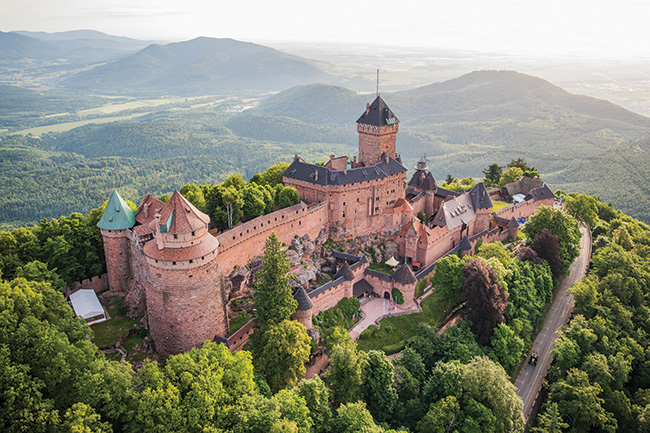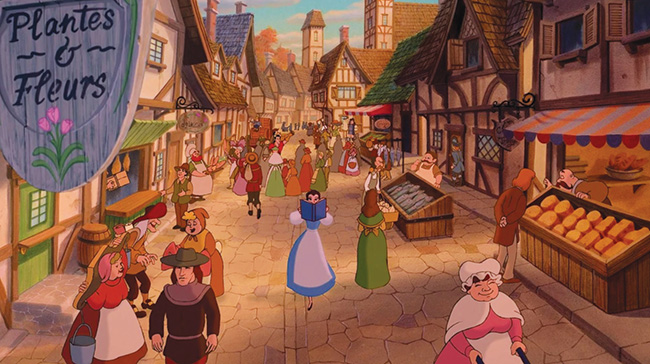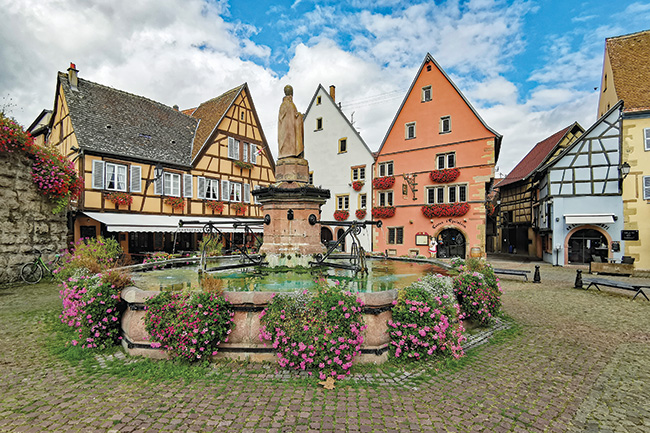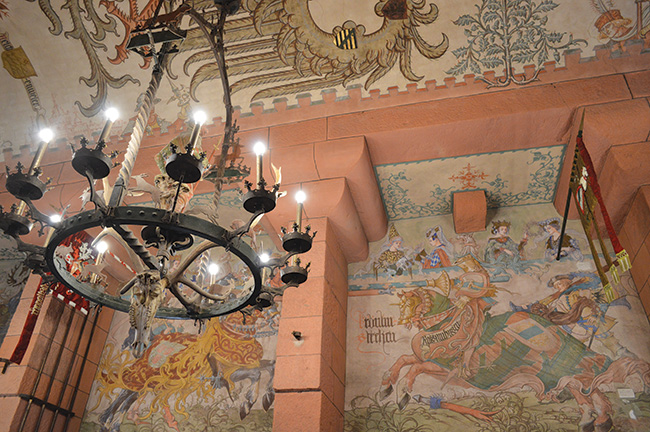In the Footsteps of Beauty and the Beast


Chloe Govan heads to Alsace in search of the locations that inspired Disney’s animated movie and the 18th-century origins of this French fairy tale.
Most visitors to Alsace flock to its world-famous Christmas markets, or aim for the vineyards to indulge in a romantic wine-tasting break. Yet this visually spectacular region, with its flower-framed riverbanks and rainbow-coloured half-timbered houses, has another string to its bow: it doesn’t just look like it was plucked straight out of a fairy tale – it really was the inspiration for one of the world’s best-loved stories. So why not pause a moment before pouring that glass of wine and follow first in the footsteps of one of Disney’s most famous fairytale characters – Belle, of Beauty and the Beast?
Walt Disney himself had French ancestry – his roots can be traced back to the tiny dairy town of Isigny-sur-Mer in Normandy, where his ancestors became the Lords d’Isigny, before moving to England and anglicising it to Disney. And France’s Rococo interiors and romantic châteaux have inspired many a Disney set. So when it came to creating the 1991 animated version of Beauty and the Beast, the producers could think of no better setting for Belle’s home than Alsace.

Colmar is one of the places which inspired the 1991 animated Disney movie Beauty & the Beast © Xiyang Xing
Colourful Villages
The streets Belle calls home in the movie are almost identical to some of those seen in Colmar, Riquewihr and Ribeauvillé, all within a one-hour drive of the region’s main city, Strasbourg. She is portrayed as a conflicted outsider who longs to break free from the beautiful, yet predictable, small town she lives in – but when her plans are unexpectedly sidelined and she finds herself trapped in the château of a formidable beast, she gets a little more adventure than she’d bargained for.
The start of the movie portrays the Disney princess tiring of her daily routine, buying freshly baked bread from the local boulangerie and borrowing books from her local library. She sneers at her surroundings in spite of the stunning views, branding the location a “poor provincial town”. While Belle might have been ungrateful enough to regard her fairy tale town as boring, visitors are likely to find the real streets of Alsace anything but mundane. Many houses date back to the medieval era, and in spring and summer, giant storks’ nests poke out from the top of tall buildings, introducing visitors to the region’s much-celebrated mascot. Visitors will also be struck by the veritable rainbow of colours: traditionally, a house was vibrantly painted according to the profession of its occupants – for example, yellow for a baker, or blue for a sailor – and to this day, there is still barely a dull home around.

A street scene from Disney’s Beauty & the Beast
Dramatic Past
But beauty aside, the area carries with it a dark and dismal history. Straddling the border between France and Germany, ownership of the region was hotly contested over the centuries. It was annexed by Germany in 1871 following its victory in the Franco-Prussian War. Then in 1918, when the Germans lost the First World War, it was returned to the hands of the French… before falling into the grip of the Nazis in the Second World War.
There are those still alive today who can recall being compelled to take on German citizenship during the Occupation. The invaders were on a mission to erase French culture, destroying statues of key French figures and even banning berets, once an almost obligatory fixture of young boys’ school uniforms. Not surprisingly, there are still some unmistakably Germanic cultural traits that remain – including the age-old tradition of the beer tavern.
Back to the movie, eagle-eyed viewers of Belle’s failed wedding scene will discover undeniably French references – for instance, the beverage with a tell-tale white stripe on the bottleneck, with a dot in the centre, is a clear nod to Alsatian wine.

Eguisheim’s picturesque fountain © Paul T Gunther
Meanwhile, although the location of the Beast’s lair is said to have been inspired by Château de Chambord in the Loire Valley, it’s far more likely that the one Belle’s father stumbled upon while out riding his horse was the much nearer Château du Haut- Koenigsbourg. An unjustly underrated castle perched atop a spectacular rocky outcrop, its panoramic views, reaching as far as the Black Forest, are nothing short of jaw-dropping. The medieval fortress, which has played its part in repelling invaders since the 12th century, is a must-see attraction for visitors to Alsace. Looking out from its ramparts affords views of France, Germany and Switzerland. Its gory history includes being burnt down by Swedish invaders, lying abandoned in ruins for two centuries, and then being restored by the German emperor Wilhelm II after the Franco-Prussian War. Ultimately, though, it fell back into French hands.

A detail from the interior décor of Château du Haut-Koenigsbourg © Chloe Govan
The castle is just 16 miles from Colmar – Belle’s “provincial town”. Need further convincing of the true location? Check the scene where a book-wielding Belle twirls around a fountain singing to a vast herd of neighbourhood sheep. A strikingly similar one, the Schwendi fountain, exists in Colmar, complete with a statue erected by Frédéric Bartholdi, the creator of the Statue of Liberty.
Bartholdi was born in Colmar in 1834 and his birthplace is now a museum, showcasing his work alongside family artefacts, drawings, furniture and photographs. Like Belle, Bartholdi had a burning wanderlust, travelling through Yemen and Egypt and to the USA, where his Statue of Liberty found a home and he found a wife.
The nearby village of Eguisheim also lays claim to Beauty and the Beast fame, insisting that the Saint-Léon fountain in its central square is the true location around which Belle is dancing. Meanwhile, the village’s landmark beauty spot, le Pigeonnier (dovecote) – one of the most stunning buildings in the entire region – looks a lot like Belle’s family home in the subsequent 2017 movie, although many would argue it was inspired by the equally fairy tale Conques (Aveyron), a mammoth eight-hour drive away.
These picturesque locations look exactly like the places where happily-ever-after stories might be set – but there’s evidence to suggest that, far from the innocent connotations it has today, the original fairy tale had a much darker side to it.
The original version of La Belle et la Bête was written by Gabrielle-Suzanne de Villeneuve and published in 1740. In 1748, it was revised by Jeanne-Marie Leprince de Beaumont as a moral tale for young girls and this is the version best known today. During the 18th century in France, child brides were married off to men decades older. The tale could, therefore, be interpreted as a comfort blanket of sorts: a frightened young girl embarking on married life with someone she didn’t choose should give her husband (‘the beast’) a chance, for if she learns to love the man who is holding her captive, he will eventually turn into the prince of her dreams. Reality, of course, is likely to have been very different from the fairy tale. Some might say the story was a warning to girls who, like Belle, longed for adventure but that they too would have their wings clipped.
For today’s audience, of course, the dark undertones are no longer relevant, and a more positive interpretation can take their place – that Belle is simply trying not to be shallow by judging someone on appearances. Another difference, of course, is that if Belle were around today she would surely have rallied against the Beast’s imprisonment of her and his cruelty to her father. (Talking of legal matters, head to the European Court of Human Rights in nearby Strasbourg. It’s the most important court in Europe and free to visit – just take your passport as proof of ID).

A replica of the Statue of Liberty Replica stands in Colmar © Wikimedia Commons
Festive Thrills
One of the biggest pleasures in Strasbourg, the gateway to Alsace, is strolling through the streets and soaking up the lively atmosphere
on the banks of the River Ill, where restaurants offer impossibly gorgeous views. And after a day browsing the beautiful Petite France district, the Sofitel Strasbourg is a great place to lay your weary head. Located in the historic city centre, it is tranquil and luxurious, with fabulous restaurant options that are sure to please hungry gourmands.
Fairy tales aside, as we’ve already mentioned, Christmas is big business in this part of France. Colmar is home to a vast array of Christmas-themed shops if you’re in the mood for some festive shopping. For summer visitors, it can feel surreal to be in the midst of a sweltering heatwave only to walk into the cool breeze of an air-conditioned Christmas store, with baubles swinging and tinsel glistening. Festive songs and larger-than-life Santa Claus figures greet shoppers and there’s also an opportunity to enjoy motorised advent calendars that literally come alive. The year-round festive vibe is a distinctive part of Alsatian retail culture and is not to be missed.
In Colmar’s dreamy Little Venice district, it’s almost obligatory to take a ride on the canal in one of the many tourist boats. Set right on the canal’s edge, Le Maréchal hotel is housed in a building that dates back to 1565, and has a fantastic gastronomic restaurant with views directly onto the water.
From Colmar, it’s possible to take trips to villages such as vineyard-flanked Ribeauvillé and picture-perfect Riquewihr (just ten minutes’ drive from each other), as well as the likes of Eguisheim. One especially charming hotel in this area is Ribeauvillé’s Hôtel de la Tour, which has beautiful balconies looking out over window boxes filled with flowers down to the village below.
While Belle found her happy ending by turning a beast into a prince, in a region as beguiling as this there’ll be no need for any transformations. Whatever the time of year, following in the footsteps of fairy tales is sure to be a dream come true in Alsace.
From France Today magazine
Lead photo credit : The setting of the Château du Haut-Koenigsbourg will take your breath away © Tristan Vuano
Share to: Facebook Twitter LinkedIn Email
More in Beauty and the Beast, Disney, films inspired by France, French culture, walt disney
By Chloe Govan
Leave a reply
Your email address will not be published. Required fields are marked *



